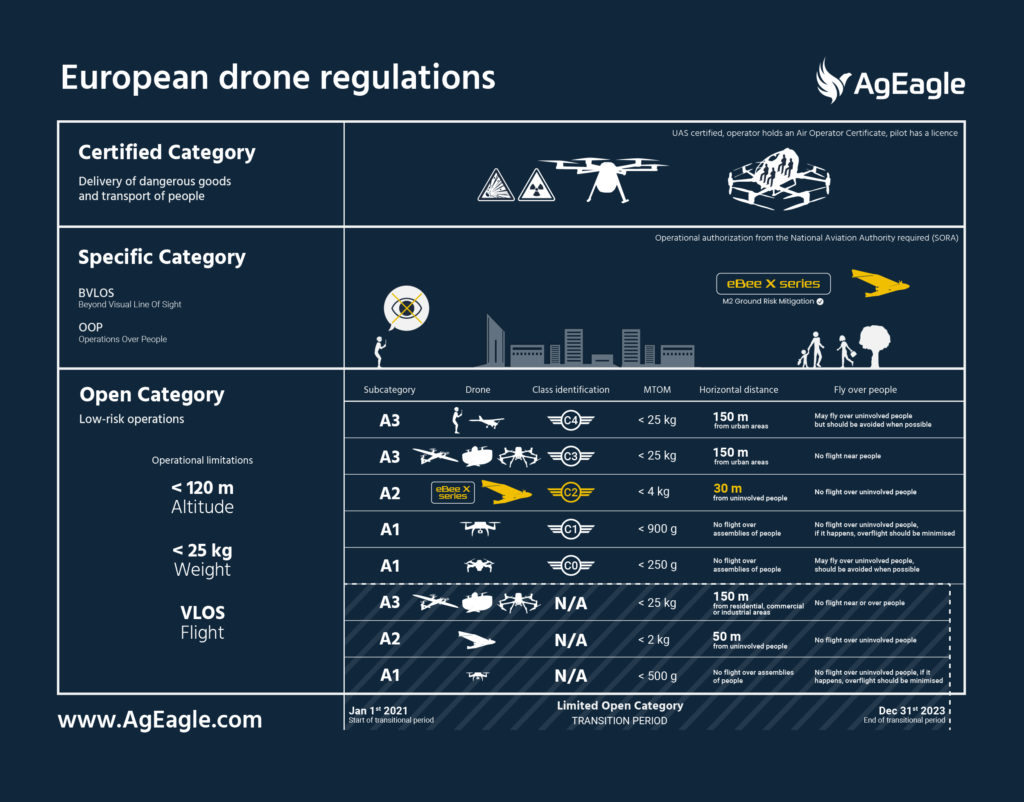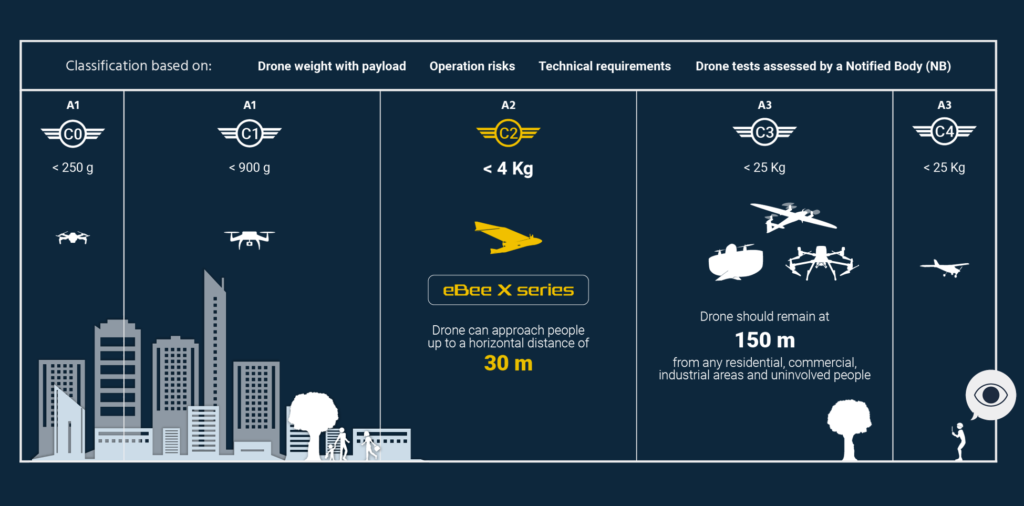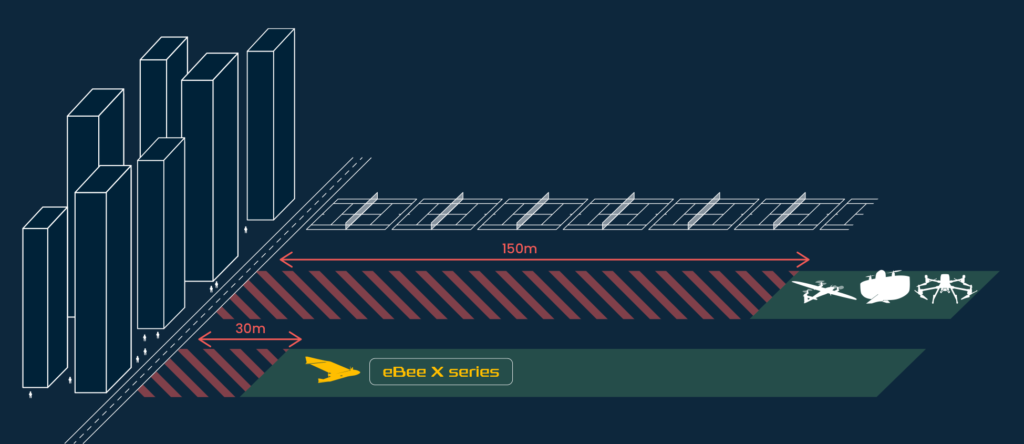TABLE OF CONTENT
- Introduction
- Overview of the current European drone regulations
- In detail – Operation categories
- Before buying a drone
- Additional content on EU drone regulations
Introduction
On 1 January 2021, the European Commission harmonized civil drone regulations across the following countries: European Union’s 27-Member States + Iceland, Lichtenstein, Norway, Switzerland (process ongoing), and United Kingdom (partially).
The regulations require all operators of drones above 250 g to register with their country’s National Aviation Authority (NAA). This can be where the operator lives or at their principal place of business. This registration is valid for the period defined by the NAA.
Once registered, the operator receives a registration number that must be displayed on all its drones and uploaded onto the remote identification system. This number is recognized in all European Union member states.
Arnold’s Head of Regulation Pierre-Alain Marchand explains the current European drone regulations in this blog post.
Overview of the current European drone regulations

The European regulatory framework (2019/945 and 2019/947) takes an operation risk-based approach, which considers the drone’s weight, technical and safety specifications and the type of operation being conducted.
There are three categories of drone operations in the EU regulations:
Certified Category
- High-risk operations: like the delivery of dangerous goods with a drone or flying taxis.
- Required: Operational authorization from the NAA.
Specific Category
- Advanced operations: EVLOS, BVLOS, OOP, package delivery, and more.
- Flights pose a level of risk not covered under the Open Category.
- Four operation procedures to obtain approvals: Specific Operation Risk Assessment (SORA), Predefined Risk Assessment (PDRA), Standard Scenario (STS) or Light UAS Operator Certificate (LUC).
- Required: Operational authorization from the NAA.
Open Category (including transitional Limited Open Category)
- Low-risk operations: max. altitude 120 m above ground level (AGL), VLOS flights and drones under 25 kg.
- Applies to most drones that do not transport goods and do not conduct advanced operations.
- Not required: Operational authorization from the NAA.
- Composed of:
- Limited Open Category: Transition period from January 2021 until December 2023 to give manufacturers time to certify their drones for the Open Category. Based on the drone’s maximum take-off weight (MTOW).
- Open Category: The drone entries this category once assessed by a Notified Body and granted with one of the class identifications C0, C1, C2, C3, C4. Based on the drone’s maximum take-off weight (MTOW) + technical and safety specifications.
- Open Category is subdivided into:
- Operational subcategories: A1, A2, A3, indicating flight limitations for the drone.
- Drone class certifications: C0, C1, C2, C3 and C4, indicating drone’s weight and related specifications. The higher the class number, the greater the operational limitations.
In detail – EU drone regulations operation categories
Open Category
The Open Category for low-risk operations is composed of:
- Limited Open Category – transition period to give manufacturers time to certify their drones.
- Open Category – for certified drones.
Both are for UAS under 25 kg and have the following operational limitations: max. flight altitude 120 m AGL and visual line of sight (VLOS) flights.
Operations in the Open Category do not require authorization from a National Aviation Authority (NAA) because they are considered low risk.
Transition period: Limited Open Category

To give drone manufacturers time to certify their drones for the Open Category, a Limited Open Category transition period is in effect until December 2023.
This Limited Open Category is composed of three subcategories based on the drone’s maximum take-off weight including payload (MTOW):
A1 subcategory – For drones below 500 g MTOW
- No flight expected over uninvolved people. If it happens, overflight should be minized.
- No flight over assemblies of people.
A2 subcategory – For drones below 2 kg MTOW – eBee X series
- No flying over uninvolved people.
- Keep a horizontal distance of 50 m from uninvolved people.
A3 subcategory – Drones between 2 kg and 25 kg MTOW – WingtraOne GEN II VTOL, Quantum Trinity F90+ eVTOL and DJI Matrice 300 RTK
- Do not fly near or over people.
- Fly at least 150 m away from residential, commercial or industrial areas.
Open Category

The drone entries this category once assessed by a Notified Body and granted with one of the class identifications C0, C1, C2, C3, C4. The higher the class number, the greater the operational limitations. The drone manufacturer is responsible for certifying the drones.
The Open Category is subdivided into:
- Operational subcategories A1, A2, A3, indicating flight limitations for the drone. General operational limitations include a max. altitude 120 m AGL, VLOS flights and drones under 25 kg.
- Drone class identifications C0, C1, C2, C3 and C4, indicating the drone’s weight, technical and safety specifications. The higher the class number, the greater the operational limitations.
COMPARISON: C2-A2 vs C3-A3
The most common class identifications for professional drones are C2 and C3, operating in Open Category A2 and A3.
C2 class drone flying in subcategory A2 – e.g. eBee X series
- Drones between 900 g and 4 kg.
- No flight over uninvolved people.
- 30 m horizontal distance from uninvolved people.
- Can fly in residential, commercial, and industrial areas.
C3 class drone flying in subcategory A3 – e.g. WingtraOne GEN II VTOL, Quantum Trinity F90+ eVTOL and DJI Matrice 300 RTK
- Drones between 4 kg and 25 kg.
- No flight near people nor residential, commercial, and industrial areas.
- 150 m horizontal distance from uninvolved people.
- Operational capability limited to remote areas.

Main differences Limited Open Category vs. Open Category
| Limited Open Category | Open Category | |
| Dates | Until December 2023 | January 2021 onwards |
| Operational subcategories | A1, A2, A3 | A1, A2, A3 |
| Class identification labels | N/A | C0, C1, C2, C3, C4 |
| Classification procedure | Operational subcategory assigned automatically based on: – Drone’s maximum take-off weight including payload (MTOW) | Classification label obtained following conformity assessment by a Notified Body based on: – Drone weight with payload – Operation risks – Drone safety & technical requirements |
| eBee X series | For eBee X series drones on the market that have not undergone the C2 update. A2 subcategory Do not fly over uninvolved people. Maintain a horizontal distance of 50 m from uninvolved people. | All eBee X series drones C2 certified shipped in Europe by Arnold from September 2022. C2 class flying in A2 subcategory Do not fly over uninvolved people. Maintain a horizontal distance of 30 m from uninvolved people. |
| Drones above 4 kg e.g. Wingtra, Quantum Systems and DJI Matrice 300 RTK | A3 subcategory (>2 kg) Do not fly near or over people. Fly at least 150 m away from people and residential, commercial, or industrial areas. | C3 class flying in A3 subcategory (>4 kg) Do not fly near people. Fly outside urban, residential, commercial, and industrial areas, at 150 m distance. |
eBee drones C2 certified and non-certified
All eBee X, eBee Ag and eBee Geo drones shipped in Europe by Arnold from September 2022, include the C2 label at no extra cost.
For eBee X series drones already in the market, we will provide customers with an option to be C2 compliant by December 2023, when the Limited Open Category concludes.
Operational advantages of C2 drones:
- Can fly at 30 meters from uninvolved people in Europe without authorization. By contrast, VTOLs and quadcopters above 4 kg must maintain 150 meters.
- Huge market differential for eBee operators, as they will be able to operate their drone in areas prohibited to heavier UAS.
If your business operations require flying BVLOS, OOP, or near residential, commercial, industrial, or recreational areas – not accessible to heavy VTOLs and quadcopters – you can now benefit from the regulatory advantages of C2 lightweight drones by upgrading to an eBee fixed-wing UAS.
For more information contact us at contact@arnold.fit.
Specific Category
This category applies to drone operations which pose a level of risk not covered under the Open Category, such as extended visual line of sight operations (EVLOS), beyond visual line of sight (BVLOS), operations over people (OOP), or package delivery.
One of four procedures should be followed to operate in this category, for all of which the drone operator is required to obtain a National Aviation Authority (NAA) authorization:
Specific Operation Risk Assessment (SORA): The suggested method for eBee users, as they benefit from a simplified process thanks to eBee X series drones M2 Ground Risk Class (GCR) mitigation. Drone operators are required to perform a risk appraisal using the Specific Operations Risk Assessment (SORA) methodology. This 10-step process defines the risk of the mission, that will be assessed by the NAA. For more info on SORA, read here.
The eBee X series drones are the industry’s first UAVs to receive a Design Verification Report from EASA on the M2 Ground Risk Class (GRC) mitigation, a step in the SORA process to obtain BVLOS and OOP approval.
As a result, eBee X operators benefit from a simplified SORA authorization process by having a lower ground risk score without needing additional verification from EASA.
Predefined Risk Assessment (PDRA): This is an assessment to conduct basic advanced operations (such as EVLOS at 120 m / 150 m) in Europe, with a scenario already covered by one of the EASA published PDRAs. Because the risk of the operation is lower, instead of conducting a full risk assessment, the operator will have to provide some documentation to support the application for NAA authorization.
Standard Scenario (STS): Upcoming. Analogous to the PDRA, but the drone must have a class marking (C5 or C6). The mission is conducted under a predefined operation published by the EASA. The operator must submit an operation declaration to the NAA where he/she is registered and await confirmation.
Note: Upcoming class identification C5 and C6 will be available for Standard Scenarios. When available, the eBee X series will apply to obtain C6 certification for BVLOS operations with airspace observers over a controlled ground area in a sparsely populated environment (STS-02).
Light UAS Operator Certificate (LUC): Rare certificate to which only organizations can apply after filling the requirements. It’s mainly for repetitive missions with the same operational characteristics. Organizations with a LUC certificate can self-assess the operation’s risk and self-authorize it under their responsibility.
Certified Category
Operations that fall under the Certified Category are those that are believed to pose the highest risk because they would likely involve the transportation of people or dangerous goods, envisioned for air taxis or cargo drones.
Before buying a drone
Purchasing a drone that matches your operational needs and with EU drone regulation compliance in mind can simplify your operation processes. We strongly recommend that you check:
- Which class identification label of the Open Category the drone is being assessed and the operational limitations it will imply. The eBee X is the first UAS to receive the C2 certification, allowing operators to fly near areas not allowed to drones above 4 kg, such as VTOLs and quadcopters.
- For the Specific Category, if the drone has approved mitigations, such as the eBee X’s M2 ground risk mitigation. This simplify and accelerate mission authorizations, such as flying BVLOS or OOP.
- If the drone manufacturer has an internal regulations team that can guide you through obtaining operational authorizations. Arnold has in-house drone regulation experts.
- The training requirements for the different subcategories.
For more information about the EU or other drone regulations, contact us directly at contact@arnold.fit
DISCLAIMER
Arnold Aerial Systems Inc provides this information for informational purposes only. The texts, graphics, images, and references don’t constitute legal advice. While we try to keep the information timely and accurate, we make no guarantees. Arnold Aerial Systems Inc. is not liable for the actions taken based on this document’s information.
Additional content
Video –








